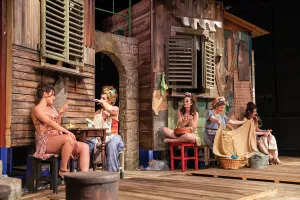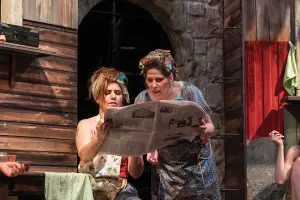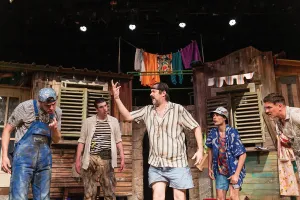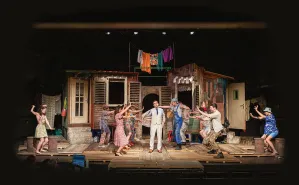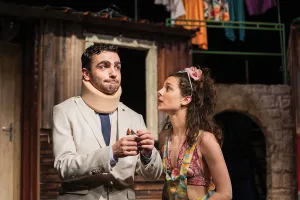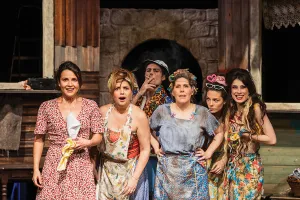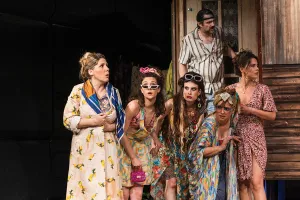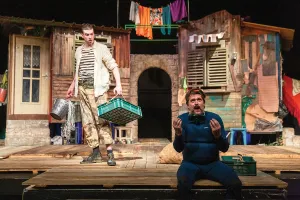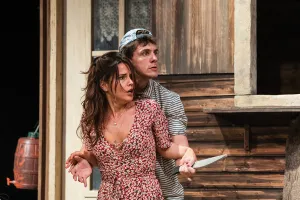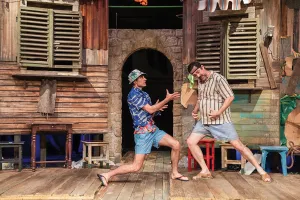Squabbles at chioggia
comedy by Carlo Goldoni
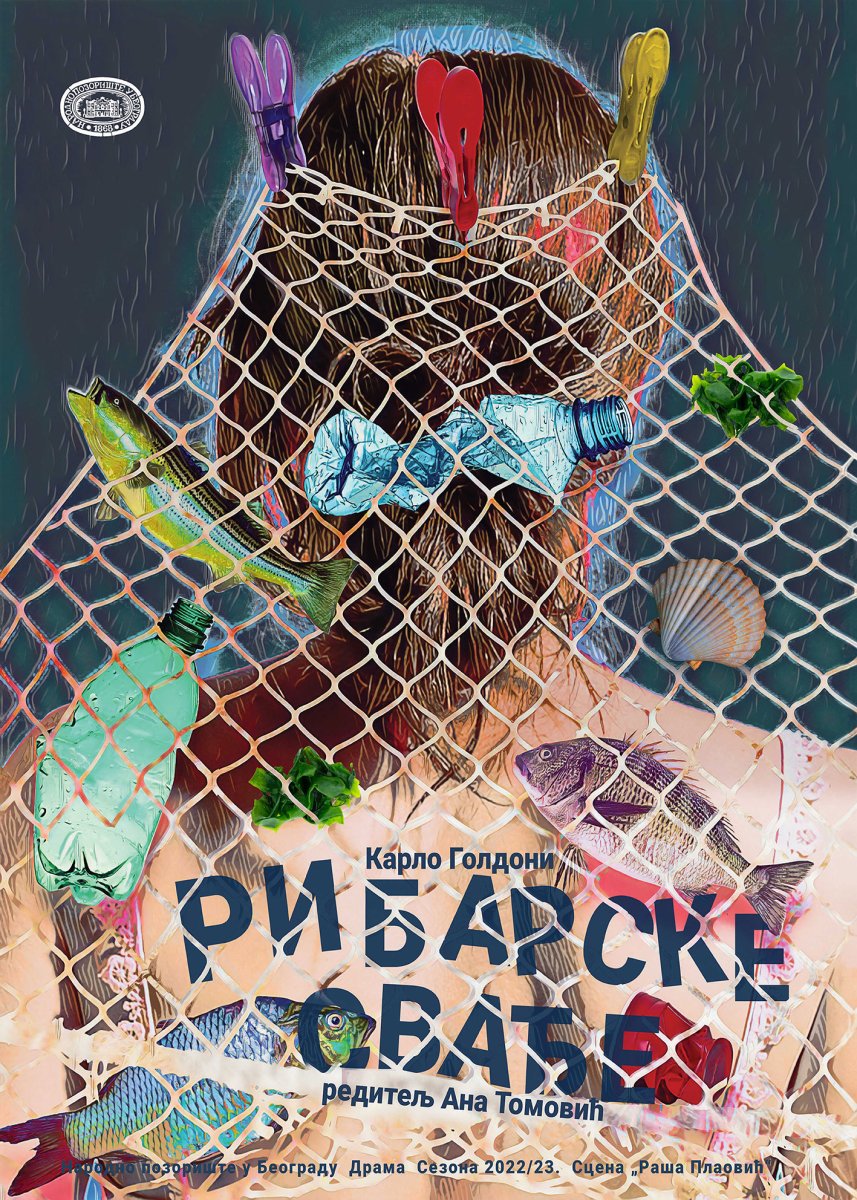
A Word from the Director
Goldoni's comedy of character “Brawling in Chioggia” captivates the audience even after two hundred and fifty years with its humorous and moving portrayal of jealousy derived from love and poverty. A quarrel that breaks out trivially between two poor fishing families living next to each other in a small fishing village and both have girls of marriage age, escalates to unimaginable proportions under the influence of the sirocco – a warm wind blowing from the sea, but also because of hard-headed and proud characters who have nothing else in this world other than their honour.
Undoubtedly, this comedy resonates differently in every period – in 2023 sea and sea coast are exposed to environmental catastrophe caused by the greed of neoliberal capitalism. Uncontrolled use of plastic results in enormous pollution of the coast and the sea, and particularly marine species. Large companies’ monopoly deprived small fishermen of their livelihood. Therefore, in my interpretation, Goldoni’s comedy is not a romantic but rather apocalyptic vision of the world.
“Brawling in Chioggia” also tells about the efforts of a town clerk to figure out what really troubles the people who have feuded, not to punish or imprison them, but to approach them as a human being who is personally involved in the search for a solution. Humanity and empathy are the only bulwark of defence against the evil in today's world. How often do we encounter such a personal approach of man to man in today’s judicial bureaucratic labyrinths and find understanding of a man’s pain and struggle for existence, as well as willingness to help?
That kind of awareness of the world we live in today will be reflected in the stage setting, first of all, in the elements of scenography or “context” where and when this universal love comedy takes place. In working with actors, I want us to stay on the trail of warmth, love and humanity, and above all on the trail of very good characterisation of characters that make audience laugh and rejoice.
Ana Tomović
Goldoni: The Reformer of the Italian theatre
Carlo Goldoni was born in the Republic of Venice at the beginning of the 18th century, at a time when commedia dell'arte has been dominating the theatre already for a century and a half. Exactly in the middle of the century, Goldoni, in a preface, sets the manifest about changing comedy from improvisational, focused on acting (such as commedia dell'arte) to comedy that returns to the dramatic text, characters and plot. Who was this playwright, theatre reformer, but also an active lawyer?
Since his early childhood, Goldoni attended the musical plays of the small theatre that his spendthrift and light-hearted grandfather built in his villa, as well as the puppet theatre that his father, a doctor, made for him. In the course of his education path towards becoming a lawyer, Goldoni kept finding getaway into the texts of Plautus, Terence, Aristophanes and other comic classics; he literally ran away from the Dominican catholic school to join an acting company; and he was expelled from his studies in Pavia because of a satire he wrote (at the persuasion of his colleagues) which caused public scandal and insult. His life was marked by similar predicaments and tragicomic situations (especially love-related), but Goldoni's nature would colour it with cheerfulness and optimism. Young Goldoni, along with completing his law studies, also worked at a criminal law office in Chioggia, a small town near Venice. This experience, which enabled him to interact with colourful locals on a daily basis, would later prove to be essential to him writing “Brawling in Chioggia”. After Chioggia, Goldoni established his legal practice in Venice, but soon devoted himself more and more to theatrical work and play writing.
According to the data that Goldoni himself recorded, during his life he wrote 150 works, among them all kinds of comedies, burlesques, dramas, tragedies and opera librettos. Goldoni's most famous works are: The Servant of Two Masters (Il servitore de due padroni, 1745), The Liar (Il Bugiardo, 1750), Mirandolina (La Locandiera, 1751), The Curious Women (Le donne curiose, 1752). Even today, people gladly stage Goldoni’s plays thanks to his lapidary dialogues, striking and diverse characters, and his ability to create a real dramatic conflict out of a completely harmless situation.
*
In order to understand why Goldoni's reform is so significant and in what exactly it is reflected, we must pay some attention to the commedia dell'arte, named like that because it featured actors who were masters of a trade, professional companies who lived off their art[1]. Commedia dell'arte originated from the 16th century as a reaction to erudite comedy, a learned literary imitation modelled after Latin texts. It owed its appeal to the expressive interpretation of the actors, funny stage movements, mime gestures, acrobatic skill and spontaneity of individual improvisation. At the moment when Goldoni began his theatrical work, when actors based their art and fame on the improvisation of unwritten roles, Goldoni wrote comedies that focused on the text as the basis of comedy. Goldoni's reckoning with commedia dell'arte was not reduced only to formal and technical changes, but also to the introduction of full-blooded characters, plausible situations, logical plots and “noble, rather than burlesque” comedy.
In his manifest from 1750, Goldoni outlined the goals of the “new” comedy. It consisted of several elements. First, Goldoni would assign texts to the actors of his time, who built their careers on improvisation, trying, like Shakespeare 150 years earlier, to have the actors “say no more than they are assigned to say.”
Secondly, in his works, Goldoni tried to change the theatrical style from “farce” to “comedies of character”. In his opinion, farce was based on theatrical conventions - used gags and worn-out archetypes of commedia dell’arte, which after two centuries of use had become clichés. Goldoni hoped that the new comedy of character would revive the theatre with realistic elements depicting the modern life of the middle-class. Merchants, courtiers, waiters and other real people from Goldoni's time appear among the characters, presented not as simplified types but as multidimensional characters.
The last and most controversial of Goldoni's reforms was the demand that actors perform without their much cherished leather masks. Namely, the characteristic of commedia dell’arte was that the mentioned archetypes were clearly marked with recognisable leather masks, which were a source of Italian national pride, even outside the theatre domain. Goldoni described how people attacked and accused him of destroying Italian culture by taking off the masks. However, Goldoni saw himself as a prophet of the future, trying to point out that contemporary, realistic theatre required a nuance and life that a mask would not allow: “In our time, an actor must possess a soul; and a soul under a mask is like fire under ashes.”
Despite the nominal reform, Goldoni's comedy, in practice, still retained the elements of commedia dell’arte, present somewhat in the characters and the plot, but mostly in the characteristic rhythm of the dialogue. This is certainly not naturalism, but some benevolent and slightly ironic, optimistically bourgeoisie Goldoni's realism.
Đorđe Kosić
[1] Latin term “Ars” that commedia dell'arte derives from is translated as a skill, mastery, rather than art.
Premiere performance
Premiere July 2, 2023
„Raša Plaović“ Stage
Carlo Goldoni
SQUABBLES AT CHIOGGIA
Translation Ivo Tijardović
Adaptation Ana Tomović, Đorđe Kosić
Directed by Ana Tomović
Dramaturge Đorđe Kosić
Set Design Andreja Rondović
Costume Design Marija Marković Milojev
Composer Irena Popović
Stage movement and choreographer Andreja Kulšević
Vocal Coach phd Ljiljana Mrkić Popović
Producers Jasmina Urošević, Olivera Živković
Stage Manager Ana Zorić
Prompter Ljubica Raković
Assistant Director Vuk Ršumović
Assistant Set Designer Ema Pavlović
Assistant Costume Designer Ena Krotić
Dramaturge in practice Jefimija Sekulović
Produsers in practice Jana Šantrić, Danica Jevtić
Premiere cast:
Paron Toni Branislav Tomašević
Šjora Paškva Ivana Šćepanović
Lucijeta Tamara Šustić
Bepo Vučić Perović
Ivanko Jovan Jovanović
Paron Furte Hadži Nenad Maričić
Šjora Libera Zlatija Ivanović
Uršula Iva Milanović
Keka Teodora Dragičević
Krište Dragan Sekulić
Iže Nedim Nezirović
Light Operater Srđan Mićević
Make-Up Marko Dukić
Stage Crew Chief Zoran Mirić
Sound Operater Nebojša Kostić and Tihomir Savić
SET AND COSTUMES WERE MANUFACTURED IN THE NATIONAL THEATRE WORKSHOPS

